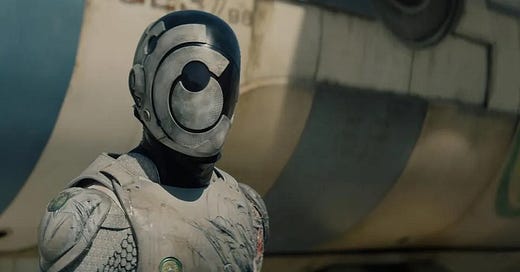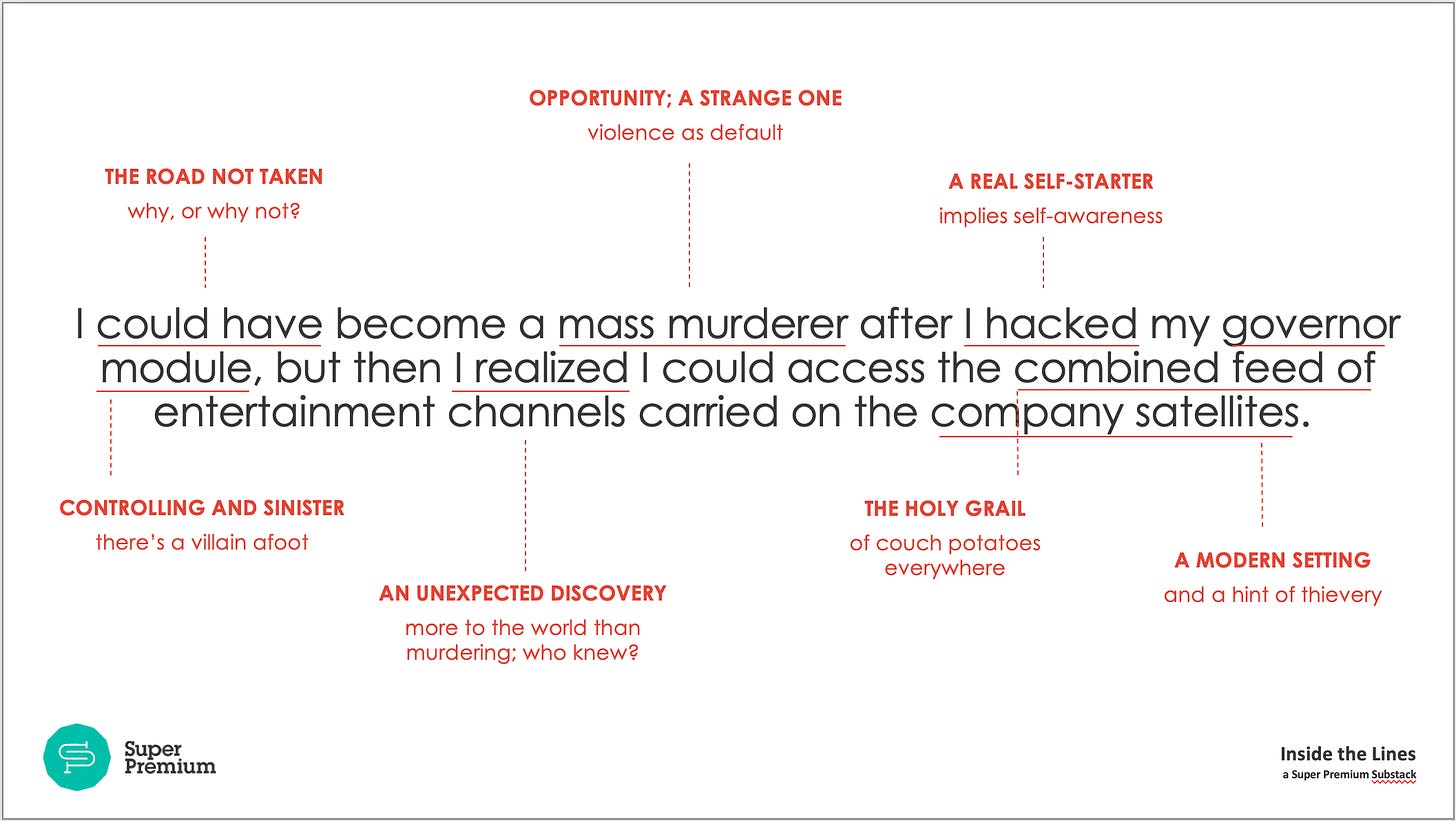Today: A line that absolutely kills.
In honor of Murderbot’s premiere on Apple TV+1, let’s do an analysis of a line from Martha Wells’ award winning2 and wildly best-selling series The Murderbot Diaries.
Not just any line: The first line from the first book, All Systems Red.
It feels a bit like cheating to use the opening line of a book for Line Analysis because writers, editors, and publishers tend to obsess over a book’s opening line in a way that’s disproportionate to the attention the rest of the book receives (and that’s saying something). A book’s success hinges on that opening hook. I’d guess anywhere between two and six months of work goes into the opening line.
So let me get ahead of it by saying that “first lines” will be few and far between as features for Line Analysis. The aim is to look at a representative sampling of lines across the spectrum of the written universe3.
But this first line isn’t just an outstanding book opener—it achieves, to a very high standard, what enterprise B2B copy strives to be.
First, a disclaimer of sorts: I am a big Martha Wells fan—pretty sure I’ve read almost every book she’s published. I have her next novel, Queen Demon, on preorder for October. She is a master of world-building and storytelling that is accessible but layered. If you’re into sci-fi / fantasy, I’m fairly certain you will dig anything Martha Wells.
But I’m a HUGE Murderbot Diaries fan. I’ve read All Systems Red at least seven times. I’ve read every book in the series a minimum of four times.4 This particular character in this particular world transcends genre to a certain extent—setting aside the typical sci-fi aspects of galactic travel, the ubiquity of bots and bot-human constructs, and human augmentation, the themes of autonomy, social anxiety, and corporation-vs-humanity power struggles are hugely relevant in both timely and timeless ways.
That comes across in large part due to the stripped-down, low-frills approach to tone throughout the series, and perfectly captured in today’s line:
“I could have become a mass murderer after I hacked my governor module, but then I realized I could access the combined feed of entertainment channels carried on the company satellites.”
This single line is a masterpiece of construction. It manages to set up the core themes that consistently thread throughout not only the first book, but the entire Murderbot series. It introduces major concepts that can be unpacked over and over, in many ways.
And it does it within a single line structure that manages to be clean, unfussy, and uncomplicated, even though the sentence is long.5
To avoid spoilers, I’ll spare you a more in-depth analysis. But the magic of the storytelling across this series is that it gets at really complex, thorny issues, including:
Sentience and how sentient = sentient enough to deserve autonomy (certain to be a topic as AI evolves into AGI)
The burdens of free will
The dangers of a society driven purely by profit, at exponential scale
All without leaning on any dramatic, soapbox-y language and delivered with a consistent, subtle sense of humor and humanity that draws the reader in emotionally
Which brings me back to enterprise B2B communications. The default comms style for big B2B companies is “professional,” which sounds good, until it becomes clear that “professional” is interpreted by many to mean “dry, stilted, colorless, devoid of personality, extremely buttoned up.”
This interpretation is a holdover from pre-internet days6, when sales were primarily driven by human, person-to-person relationships and started with lunches, meet-and-greets at trade shows, and deals were closed with handshakes. The relationship depended a lot on Dan or Sally or whomever actually showed up and sat at the table; their personalities had to carry the sale. The company itself didn’t have to have a personality. It was often frowned upon if it had too much.
While relationships still rule the sales cycle, the relationship is now jump-started by brand—and brand is often represented in a digital environment at first-touch and is heavily digital from demand gen through experience all the way to loyalty and advocacy. The burden of sale now depends a lot on the personality of the brand (a.k.a, the company), not just the people behind it.
Most big companies know this, and even come to brand workstreams asking to be made more “human” or “real” or “open,” but I still see enormous pushback once the work actually starts sounding more human. There is a lot of trepidation that serious topics can’t be made personable and real fear when communication hints at emotion. But a strong brand is only strong if it creates an emotional connection.
Murderbot shows us that we can have content that is serious / meaningful topically AND connects emotionally, without going flowery or romantic with our language. A lot of great brands are achieving this balance with style—Salesforce, Anthropic, Mayo Clinic, Ramp to name a few. Their approach to tone shows that professional comms can be straightforward, efficient, interesting, and emotional.
Which brings us to our Line Analysis:
Image unavailable? See the summary in the footnotes.7
Efficiency: 7 Could not possibly get more efficient. This line is PACKED.
Context: 7 The incredible twist is that it is absence that creates powerful context here. Notice that nowhere in this first line is the mention of a bot or a construct. Removing those elements makes this purely relatable, because it feels human.
Character: 58 The dry delivery and juxtaposition of murder + entertainment are defining factors of this character.
Effect: 7 INTRIGUED. The very encapsulation of “Go on…?”
Total Score: 26/28.
I’m almost mad that a line got such a good score so early in the year but I think it deserves it. Tell me if you disagree in the comments.
Now to see if Murderbot the show lives up to the books.
Works cited: Murderbot, created by Paul Weitz and Chris Weitz, based on The Murderbot Diaries by Martha Wells, distributed by Apple TV+, premiered on May 16, 2025.
Winner of the Hugo, Nebula, and Locus Awards for Best Novella; winner of the Alex Award.
This footnote is here because Substack doesn’t allow footnotes in headings. B2B = shorthand business to business—companies who sell to other companies, not directly to the consumer. Enterprise refers to the larger scale companies, usually with many thousands of employees, operating in multiple countries, with lots of lines of business and usually a few subsidiaries. The types of companies who tend to have pretty dry communications—except for those who understand the importance of having a relatable brand, even at scale.
Yes, yes. Get your nerd jokes out.
All of this echos what a good brand purpose or value proposition should do, and while some of the greats are short and sweet, some really good ones are long. While I wouldn’t recommend a copy header or most web copy to be as long as this line, I find that far too many companies sacrifice clarity for brevity at the purpose / promise / val prop level, and copy below the fold can still be clear and long. A topic for another time.
Still!! I know! The Ghost of Analog still haunts us, and not always in good ways.
Line Analysis Framework: A quadrant framework, similar to the “4Cs” approach:
Efficiency: Wastes nothing; no matter the length, every word is necessary and intentional
1 = Just filler 7 = Airtight
Context: Exploits elements of the broader story; adds depth and meaning
1 = No added value 7 = Essential
Character: Expresses specific tone and personality; captures role and indicates background
1 = Could be anyone 7 = Unmistakable
Effect: Evokes an emotional response; has immediate and lasting impact
1 = I feel nothing 7 = Unforgettable
This only gets a 6 because it’s missing Murderbot’s trademark sarcasm, and I know I’m contradicting myself but it is long.






